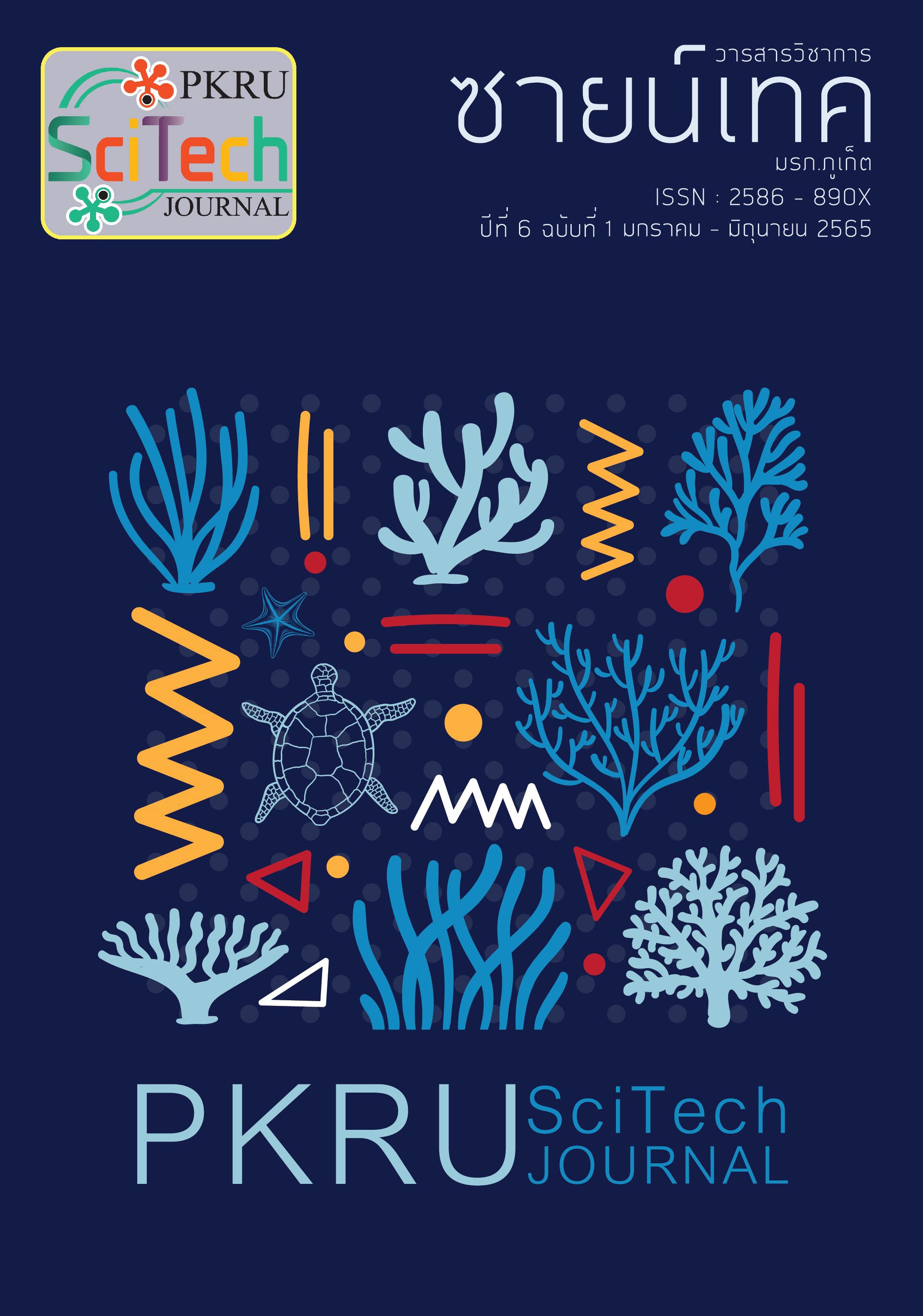Influence of Harvesting Period of Three Rice Seedlings on DPPH Radical Scavenging Activity
Main Article Content
Abstract
Presently, farmers face the problems of low-priced rice. Product processing provides an opportunity to increase the value of rice. Moreover, trend in consumption of crop sprout has been increasing in popularity. This research aimed to select the proper rice cultivars and their harvesting times to receive the highest antioxidant capacity. Three different rice cultivars (Oryza sativa L. cvs. Khao Dok Mali 105, Riceberry and Sin Lek) were studied. The results showed that fresh weight of all three seedlings at harvesting times of 7, 10 and 14 days was similar. However, at 21 days, fresh and dry weights of Sin Lek seedlings revealed higher than the others. In terms of DPPH radical scavenging assay, Riceberry seedlings on day 7 had the highest antioxidant capacity (42.86 milligrams per 100 grams of fresh weight). This was not correlated with the highest total phenolic content which found on day 21. In addition, the chlorophyll and carotenoid contents of all three rice seedlings tended to increase with the age of rice seedlings. Riceberry seedlings on day 18 exhibited the highest contents of chlorophylls and carotenoids. Therefore, in this research, Riceberry seedlings on day 7 is the most suitable for fresh consumption or for development as a product from rice sprouts due to its highest antioxidant capacity.
Article Details

This work is licensed under a Creative Commons Attribution-NonCommercial-NoDerivatives 4.0 International License.
- The original content that appears in this journal is the responsibility of the author excluding any typographical errors.
- The copyright of manuscripts that published in PKRU SciTech Journal is owned by PKRU SciTech Journal.
References
ชุติมา คงจรูญ. (2562). สารทดแทนผงชาเขียว: ผงใบข้าวหอม (หน้า 94-101). ใน การประชุมวิชาการระดับชาติ มหาวิทยาลัยทักษิณ ครั้งที่ 29 ประจำปี 2562. สงขลา.
สุรีวัลย์ ดวงจิตต์, กรกนก สุวรรณราช, กุลภัสสร์ กิตติพินิจนันท, พิชญ์นรี องค์วิสุทธิ์, สุรีวัลย์ บำรุงไทย, ธนะเศรษฐ์ ง้าวหิรัญพัฒน์, พรวนิช เจริญพุทธคุณ, และวริษฎา ศิลาอ่อน. (2562). บทบาทของสารต้านอนุมูลอิสระจากธรรมชาติสำหรับประยุกต์ใช้ทางผิวหนัง: คุณสมบัติ ประสิทธิภาพ ความปลอดภัย และระบบนำส่งรูปแบบใหม่. วารสารเภสัชศาสตร์อีสาน, 15(1), 21-48.
Aloo, S. O., Ofosu, F. K., Kilonzi, S. M., Shabbir, U., & Oh, D. H. (2021). Edible plant sprouts: health benefits, trends, and opportunities for novel exploration. Nutrients, 13, 2882-2905.
Khanthapok, P., Muangprom, A., & Sukrong, S. (2015). Antioxidant activity and DNA
protective properties of rice grass juices, ScienceAsia, 41, 119-129.
มยุรา ทองช่วง, ฉัตรกมล คุณสมบัติ, รุ้งนภา โต๊ะทอง, วรรณี นาคนาวา, กิติศาสตร์ กระบวน,
วชิราภรณ์ อาชวาคม, และนุชนาถ วุฒิประดิษฐกุล. (2562). ความสามารถในการต้านอนุมูลอิสระในต้นอ่อนทานตะวันสายพันธุ์ต่าง ๆ และอายุที่เหมาะสมต่อการเก็บเกี่ยว. วารสารวิทยาศาสตร์ประยุกต์, 18(2), 79-96.
เสรี เลาเทาะ, ชิติ ศรีตนทิพย์ และ ปริญญาวดี ศรีตนทิพย์. (2557). ความสัมพันธ์ระหว่างปริมาณคลอโรฟิลล์ สารประกอบฟีนอลิก และฤทธิ์การต้านอนุมูลอิสระกับค่าดัชนีความเขียวในผลผลิตของผักเชียงดาภายใต้อัตราปุ๋ยไนโตรเจนที่ต่างกัน. วารสารแก่นเกษตร (ฉบับพิเศษ). 42(3), 795-801.
Hsu, C. Y., Chao, P. Y., Hu, S. P., & Yang, C. M. (2013). The antioxidant and free radical
scavenging activities of chlorophylls and pheophytins. Food and Nutrition Sciences, 4, 1-8.
มหาวิทยาลัยเกษตรศาสตร์ ศูนย์วิทยาศาสตร์ข้าว. (2565). ข้าวหอมดัชนีน้ำตาลต่ำ มีธาตุเหล็กสูง. [ออนไลน์], สืบค้นจาก https://dna.kps.ku.ac.th/index.php/articles-rice-rsc-rgdu-knowledge/54-sinlek-rice (19 มกราคม 2565).
วริพัสย์ อารีกุล, ธัญวรัตม์ แซ่กู้, ปิยะนุช เชื้อวงศ์งาม, และธนกร เหล่าโรจน์ภิญโญ. (2558). ปริมาณฟีนอลิก คลอโรฟิล และความสามารถในการต้านออกซิเดชันของต้นอ่อนข้าวดำ (หน้า 1145-1151). ใน การประชุมทางวิชาการของมหาวิทยาลัยเกษตรศาสตร์ ครั้งที่ 53. กรุงเทพฯ.
Kaewneramit, T., Buaboocha, T., Sangchai, P., & Wutipraditkul, N. (2019). OsCaM1-1 overexpression in the transgenic rice mitigated salt-induced oxidative damage. Biologia Plantarum, 63, 335-342.
Brand-Williams, W., Cuvelier, M. E., & Berset, C. (1995). Use of a free radical method to evaluate antioxidant activity. LWT - Food Science and Technology, 28, 25-30.
Chan, E. W. C., Lim, Y. Y., Wong, S. K., Lim, K. K., Tan, S. P., Lianto, F. S., & Yong, M. Y. (2009). Effects of different drying methods on the antioxidant properties of leaves and tea of ginger species. Food Chemistry, 113, 166-172.
Arnon, D. I. (1949). Copper enzymes in isolated chloroplasts. Polyphenoxidase in Beta Vulgaris. Plant Physiology, 24, 1-15.
สมบุญ เตชะภิญญาวัฒน์. (2548). ชีววิทยาพืช (พิมพ์ครั้งที่ 1). กรุงเทพฯ: จามจุรีโปรดักท์.
ปณญ์ธีรา แท่งหิน, ธนิต ผิวนิ่ม, และอมลรุจี นาคพลายพันธุ์. (2560). ผลของแคดเมียมต่ออัตราการเจริญเติบโต ความเป็นพิษต่อเซลล์ราก และปริมาณรงควัตถุในข้าวไรซ์เบอร์รี่. วารสารวิชาการ Veridian E-Journal Science and Technology Silpakorn University. 4(3), 10-20.
Devi, P. S., Kumar, M. S., & Das, S. M. (2012). DNA damage protecting activity and free Radical scavenging activity of anthocyanins from red sorghum (Sorghum bicolor) bran. Biotechnology Research International, 2012, 1-9.
นิพัทธา ชาติสุวรรณ, และวริพัสย์ อารีกุล. (2553). พารามิเตอร์สี ปริมาณฟีนอลิกทั้งหมดและปริมาณแอนโธไซยานินในข้าวสายพันธุ์ต่าง ๆ (หน้า 252-260). ใน การประชุมทางวิชาการของ มหาวิทยาลัยเกษตรศาสตร์ ครั้งที่ 48. กรุงเทพฯ.
ศิรสิทธิ์ ศรีนวลปาน, และพรรณี อัศวตรีรัตนกุล. (2559). ผลของไคโตซานต่อปริมาณสารต้านอนุมูลอิสระและการต้านทานโรคใบไหม้ในข้าวสังข์หยดพัทลุง. วารสารวิชาการและวิจัย มทร. พระนคร. 10(2), 114-124.
Pinto, E., Almeida, A. A., Aguiar, A. A. R. M., & Ferreira, I. M. P. L. V. O. (2014). Changes in macrominerals, macrominerals, trace elements and pigments content during lettuce (Lactuca sativa L.) growth: influence of soil composition. Food Chemistry, 152, 603-611.
Hannoufa, A., & Hossain, Z. (2012). Regulation of carotenoid accumulation in plants. Biocatalysis and Agricultural Biotechnology, 1, 198-202.


